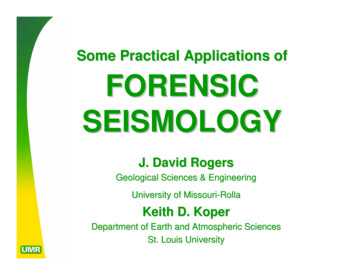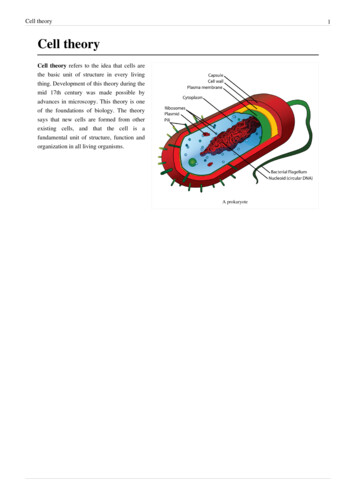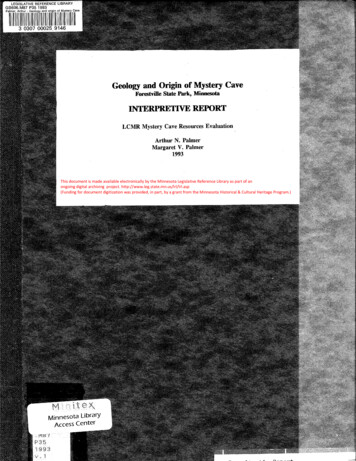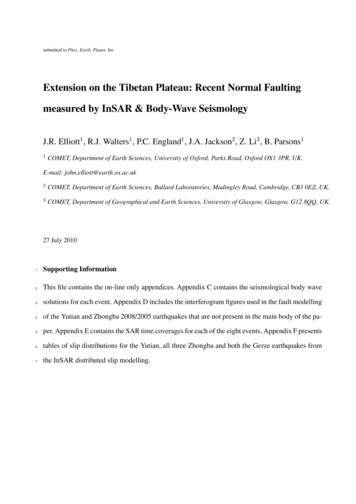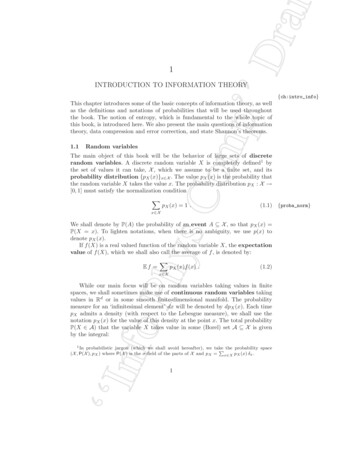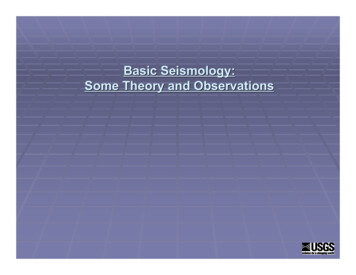
Transcription
Basic Seismology:Some Theory and Observations
Earthquakes occur as slip across a plane in the earth. Any local deformation in an elastic solid stressesnearby material, which deforms in turn, stressingnearby material, and so on The local stresses and strains are linked by theconstitutive properties of the material. Consideration of basic relationships between the forcesand deformations in the material (i.e., Newton’s Law)leads to equations describing the propagation ofseismic waves away from the energy source. These propagating waves cause most of the damage inearthquakes.
The seismic wavefield is generated at the source and modified by propagation throughthe earth medium where is reflected, transmitted, focused, scattered, and attenuated. Ourknowledge of earthquake processes and earth structure comes from both forwardmodeling and inversion of earthquake travel-time and ground-shaking data.“Introduction To Seismology, Earthquakes, and Earth Structure” by Stein & Wysession, Blackwell Publishing
Shaking at a given site, say one of engineeringinterest, is controlled by: The amount, pattern, direction, and timing of slip on thefault The distance of the site from the fault The types of geologic structures and materials along thewave path (e.g., waves can be focused by geologiccontrasts, absorbed as they pass through materials withinefficient transmission properties, etc.) The structure and physical properties of geologic materialsat the site (e.g., shaking can be amplified or diminished inan alluvial basin in complex ways depending on itsamplitude and frequency)
Development of the seismic waveequation begins with consideration ofthe forces acting on an infinitesimalplane within a homogeneous elasticmedium in static equilibrium.Forces (stress) and deformation (strain)at a point in a general elastic solid arerelated by a (81-component) fourthorder constitutive tensor. If the physicalproperties of the medium are directionindependent (isotropic), a good firstorder approximation for the earth, thenumber of independent elasticparameters reduces to two. The P-waveand S-wave seismic velocities at eachpoint in the medium can be determinedfrom these two elastic parameters andthe density.“Introduction To Seismology” by P. Shearer, Cambridge University Press
Now consider an infinitesimal cubeembedded within a homogeneous,isotropic elastic medium. If the stressfield is homogeneous there is no netforce on the cube, but spatial gradients inthe stress field generate net forces. Thecube is now in motion, and we useNewton’s Law to derive the equation ofmotion.We can use relationships between stressand strain to express stress gradients interms of displacements. These equationscan be used directly in finite-differenceequations. Otherwise, we can use vectorcalculus to derive simpler waveequations for the P-wave and S-wavefields.“Introduction To Seismology” by P. Shearer, Cambridge University Press
“Introduction To Seismology” by P. Shearer, Cambridge University Press
Real seismic wavefronts in the earth are curved, but a plane wave canbe a useful concept. (For example, a spherical wave can be expressedas a sum of plane waves.) This is the general form of a plane wave inthe frequency domain. Displacement varies in time and space (xdimension only in this case), expressed as an amplitude term times aharmonic function of frequency and slowness, s, or wavenumber, k. Aspherical wave has a similar functional form with an additionaldistance decay factor of 1/r.“Introduction To Seismology” by P. Shearer, Cambridge University Press
Solving The Seismic Wave EquationSolutions of the seismic wave equation forcompressional- (P-) and shear (S-) waves in auniform whole space are readily found, but this caseis not very interesting to a seismologist who is tryingto model seismic waves in a realistic earth.
Interesting (non-trivial) earth models that we mightwish to use contain gradients in the physicalparameters that control wave propagation, but thesefactors severely complicate solutions of the waveequation. Several approaches have been devised thatallow us to ignore the gradient terms and find anapproximate solution, yet still include some realisticstructure in the model.“Introduction To Seismology” by P. Shearer, Cambridge University Press
Homogeneous Layer Methods To first order, seismic velocity is a function only ofdepth in the earth; the earth can be modeled as aseries of homogeneous layers in which the gradientterms vanish. Wave propagation inside each layer is simple; it onlyremains to keep track of interactions of the wave field(reflection and transmission) at the layer boundaries(this is a simpler problem). A continuous 1-dimensional velocity gradient can bemodeled by simply increasing the number of layers.
Ray Methods The importance of the gradient terms varies as1/frequency, so they become vanishingly small forhigh-frequency waves. Thus, rays traced through amodel with continuous physical properties accuratelydescribe the high-frequency wave field.
Ray Theory A high-frequency approximation Simple to program, computationallyefficient, and easy to generalize to 3dimensional earth models Good for: modeling seismic phasearrival times, earthquake locationalgorithms, body-wave focalmechanism determinations, inversionsfor velocity structure Not very good for: amplitudesbecause it is a high-frequencyapproximation“Introduction To Seismology” by P. Shearer, Cambridge University Press
A seismic version of Snell’s Law fromoptics can be used to track raygeometry through inhomogeneousmaterials. Rays can be traced throughregions with continuous velocitygradients.“Introduction To Seismology” by P. Shearer, Cambridge University Press
Ray tracing results are often summarized as travel-time curves: traveltime as a function of distance from the ray source. Each point on thecurve represents a different ray path through the model. This exampleshows a case with a steep velocity increase. Locally a flat earth modelcan be used; for global studies we use a spherical earth model.“Introduction To Seismology” by P. Shearer, Cambridge University Press
Rays are a particularly useful tool forstudying global body-waves. Thismodel of the earth shows the mantle,liquid outer core, and solid inner core.Naming codes for whole-earth phases:P: P-wave in mantleK: P-wave in outer coreI: P-wave in inner coreS: S-wave in mantleJ: S-wave in inner corec: reflection off core-mantle boundaryi: reflection off inner-core boundary“Introduction To Seismology” by P. Shearer, Cambridge University Press
Seismograms are records ofearthquake ground shaking vs time.Modern seismographs record threeorthogonal components of groundshaking: one vertical component andtwo horizontal components. Groundshaking in any direction can becomputed by combining these threecomponents. To understand earthstructure and earthquake processeswe need records of ground shakingfrom a wide range of earthquakemagnitudes at a wide range ofdistances.“Introduction To Seismology” by P. Shearer, Cambridge University Press
“Introduction To Seismology” by P. Shearer, Cambridge University Press
“Introduction To Seismology” by P. Shearer, Cambridge University Press
“Introduction To Seismology” by P. Shearer, Cambridge University Press
“Introduction To Seismology” by P. Shearer, Cambridge University Press
“Introduction To Seismology, Earthquakes, and Earth Structure” by Stein & Wysession, Blackwell Publishing
Given travel-time observations, canwe find an earth velocity structurethat is consistent with the data?Typical strategy:1) Find an average 1-D velocitydepth function. This is anonlinear problem, but tractablesince we seek a single function ofdepth.2) If enough data are available wecan get a 3 -D model from traveltime residuals relative to a 1-Dreference model (seismictomography).“Introduction To Seismology” by P. Shearer, Cambridge University Press
Elegant integral-transform methods (e.g., Herglotz-Wiechert) have been developedto derive 1-D velocity models, but it can be difficult to apply formal inversions tonoisy and/or discontinuous travel-time data. A simple alternative is to fit the traveltime data with a series of straight segments. Each segment corresponds to ahomogeneous layer in the model.“Introduction To Seismology” by P. Shearer, Cambridge University Press
Variable changes and other mathematical tricks can be used tolinearize the problem and simplify the inversion. However It’s not clear that it pays to push 1-D travel-time inversionmethods much further. For example, seismograms containmore information than travel-times alone (amplitudes are verysensitive to velocity gradients) and are now readily availablein digital form.The current state of the art involves synthetic seismogrammodeling of the entire waveform, and seismic tomography, 3D inversions of large datasets of travel-time residuals(differences between observed and predicted travel-times).“Introduction To Seismology” by P. Shearer, Cambridge University Press
Seismic TomographyEach observed travel-time residual corresponds to a ray path that connects the source andreciever. This geometry must be determined for each observation, and then the travel-timethrough each block computed for each ray (this is computationally intensive). Each traveltime residual (one for each ray) can be expressed as a sum over all the blocks along theray of the product of block travel-time and block velocity perturbation. This can beexpressed in vector and matrix form, and if the number of residual measurements exceedsthe number of blocks in the model standard techniques can be used to invert for the vectorof block velocity adjustments.“Introduction To Seismology” by P. Shearer, Cambridge University Press
“Introduction To Seismology” by P. Shearer, Cambridge University Press
Earthquake Location Earthquakes are defined by their origin time andhypocenter (location of first energy release). Invertingtravel-time data for these parameters is one of theoldest challenges in seismology. Travel-time is anonlinear function of earthquake location. Common approaches:1) Iterative (linearized) inversion methods2) Master event methods“Introduction To Seismology” by P. Shearer, Cambridge University Press
To model amplitudes in ray theory wemust account for geometricalspreading, reflection and transmissionat interfaces, and anelastic attenuation.Energy in a plane wave is proportionalto the squares of both amplitude andfrequency.“Introduction To Seismology” by P. Shearer, Cambridge University Press
To account for geometricaleffects of propagation considera ray tube in which energy fluxis conserved. As the wavefrontspreads out from the source,amplitude varies inversely asthe square root of the surfacearea of the patch enclosed bythe ray tube. For a simplespherical wave the surface areagrows as r2 (r is distance) andamplitude scales as 1/r.Amplitude can actually increaseif the wave is focused duringpropagation.“Introduction To Seismology” by P. Shearer, Cambridge University Press
Ray paths of waves generated(reflected and transmitted) by a Pwave incident (upper left) on aninterface between two media withdifferent elastic properties.“The Solid Earth” by C.M.R. Fowler, Cambridge University Press
Amplitude and phase ofreflected and transmittedwaves from SH-wave incidenton interface as a function ofincidence angle.“Introduction To Seismology” by P. Shearer, Cambridge University Press
Modeling Plane Waves in LayersSome problems in wave propagation are betteraddressed by considering plane waves instead of rays,for example the amplification of ground motion dueto resonance within a near-surface layer. Powerfultechniques have been developed for modeling planewave propagation in earth models consisting ofhorizontal layers. Solutions of the seismic waveequation follow from matching displacements andstresses across layer boundaries (Thomson-Haskelland reflectivity methods).“Introduction To Seismology” by P. Shearer, Cambridge University Press
Attenuation In addition to geometrical spreading, seismic waveslose energy due to scattering and anelasticity as theypropagate. Anelasticity is sometimes called internal frictionsince seismic energy is converted to heat. Energy-dissipation mechanisms include grainboundary, grain-defect, and fluid interactions inducedby dynamic stresses as seismic waves pass by. These processes are difficult to quantify since theymust be isolated from other complex source andwave-propagation phenomena.
Attenuation is defined as the fractional energy lossper cycle of motion, and is quantified by theparameter 1/Q. The amplitude of a seismic wave can be written as aproduct of a real exponential term describing theamplitude decay from attenuation and an imaginaryexponential term describing the oscillations.“Introduction To Seismology” by P. Shearer, Cambridge University Press
“Introduction To Seismology, Earthquakes, and Earth Structure” by Stein & Wysession, Blackwell Publishing
Traditionally, reflection seismicmethods were developed to explore forpetroleum or mineral resources in theshallow crust. Repeatable, artificialseismic sources (explosions orvibrations) and arrays of seismometersare deployed at the earth’s surface, andcomputer-intensive processingmethods are used to map boundaries atdepth. Extensive data redundancy isused to suppress noise and enhance thesubsurface images.“Introduction To Seismology” by P. Shearer, Cambridge University Press
“Introduction To Seismology” by P. Shearer, Cambridge University Press
“Introduction To Seismology” by P. Shearer, Cambridge University Press
“Introduction To Seismology” by P. Shearer, Cambridge University Press
Rayleigh waves are radially polarizedwaves that propagate at the free surfaceof an elastic medium. Love waves aretransversely polarized waves that requirea vertical velocity gradient (or sphericalgeometry). Surface waves are generallythe strongest arrivals at great distancesfrom earthquakes. Compared to P and Sbody waves they travel more slowly,decay much less with distance, and theirvelocities depend strongly on frequency.“Introduction To Seismology” by P. Shearer, Cambridge University Press
“Introduction To Seismology” by P. Shearer, Cambridge University Press
“Introduction To Seismology” by P. Shearer, Cambridge University Press
“Introduction To Seismology” by P. Shearer, Cambridge University Press
Earth’s free oscillations can bederived as a sum of surfacewaves.“Introduction To Seismology” by P. Shearer, Cambridge University Press
“Introduction To Seismology” by P. Shearer, Cambridge University Press
To fully describe the earthquake ground shaking, we must also consider the seismicsource.“Introduction To Seismology, Earthquakes, and Earth Structure” by Stein & Wysession, Blackwell Publishing
Slip on a fault can be modeled as adistribution of idealized simple forcesthat produces exactly the samedisplacement field as the slip.“Introduction To Seismology” by P. Shearer, Cambridge University Press
To conserve momentum, internal forces must be specified as balanced force couples.If we can compute the ground motion from a single idealized force (the Green’sfunction) the full seismic wave field can be computed as a linear superposition. Thestrength of the force is given by the seismic moment, the product of the shearmodulus of the source medium, the slip displacement on the fault, and the fault area.“Introduction To Seismology” by P. Shearer, Cambridge University Press
“Introduction To Seismology” by P. Shearer, Cambridge University Press
“Introduction To Seismology” by P. Shearer, Cambridge University Press
“Introduction To Seismology” by P. Shearer, Cambridge University Press
“Introduction To Seismology” by P. Shearer, Cambridge University Press
Slip across the fault is generally not instantaneous, but occurs over a finite duration.The time dependence of the source controls the amplitude and timing of seismicwaves.“Introduction To Seismology” by P. Shearer, Cambridge University Press
Offsets across the fault (“near-field”) are permanent, but at greater distances thewavefield is dominated by dynamic (“far-field”) displacements that decay back to zeroafter the seismic waves pass by. The far-field displacement scales like the time derivativeof the seismic moment (previous slide).“Introduction To Seismology” by P. Shearer, Cambridge University Press
It is often more convenient to think about source processes in the frequency domainrather than the time domain.“Introduction To Seismology” by P. Shearer, Cambridge University Press
The low-frequency level of thedisplacement spectrum isproportional to the seismicmoment - the strength or size ofthe earthquake. The shape of thespectrum at higher frequenciestells us about the details of thetime dependence and complexityof the slip.“Introduction To Seismology” by P. Shearer, Cambridge University Press
Stress Drop Stress drop is defined as the average differencebetween stress on a fault before and after anearthquake. Released (“dropped”) elastic stress iswhat generates permanent ground deformation andseismic waves. We can estimate stress drop from field measurementsof average slip, fault dimension, and shear modulus. Alternatively, stress drop can be estimated fromseismic data. Seismic moment and fault rupturedimension can be estimated from the levels andshapes of source spectra, and stress drop computedfor a specific fault shape (e.g., Brune’s model).“Introduction To Seismology” by P. Shearer, Cambridge University Press
Source Scaling and MagnitudeTraditional magnitudes are measured at specific ground motion frequencies. Theseidealized source spectra show how spectral level and corner frequency scale withearthquake size. Ground motion measured near 1 Hz saturates (does not continue toscale upward with seismic moment) for earthquakes larger than about magnitude 7.This leads to inconsistencies between magnitude scales and misrepresentation of therelative sizes of large earthquakes. Seismic moment and moment magnitude overcomethese limitations of traditional period-based magnitude measurements.“Introduction To Seismology” by P. Shearer, Cambridge University Press
“Introduction To Seismology, Earthquakes, and Earth Structure” by Stein & Wysession, Blackwell Publishing
“Introduction To Seismology” by P. Shearer, Cambridge University Press
"Introduction To Seismology" by P. Shearer, Cambridge University Press. Ray paths of waves generated (reflected and transmitted) by a P-wave incident (upper left) on an interface between two media with different elastic properties. "The Solid Earth" by C.M.R. Fowler, Cambridge University Press
